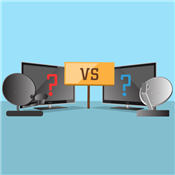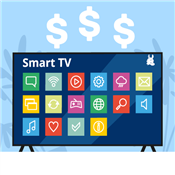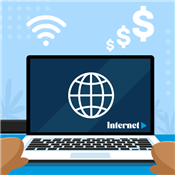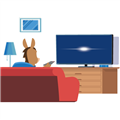Top 10 Cheap TV Service
Here are the best cheaper alternatives to cable TV. Watching TV doesn't have to be expensive. These TV providers offer popular channels at an inexpensive price.
- Best Overall: DISH ($91.99 per month)
- Best No-Contract: Sling TV ($45.99)
- Best for Sports: DIRECTV ($74.99)
- Best Streaming: Netflix ($6.99)
- Best Bundle: Hulu Live ($82.99)
- Best All-in-One: Amazon Prime Video ($8.99)
- Best Original Content: Max ($9.99)
- Best Cheap Streaming: Paramount Plus ($7.99)
- Best Cable Alternative: YouTube TV ($72.99)
Read on to learn what features to look out for, and what it might cost you.
Or simply visit the top TV providers:![]()
![]()
![]()
![]()
![]()
![]()
![]()
![]()
![]()
![]()
What to Look for in a Cheap TV Service
 |
Before we get into the recommendations, there are a few things to consider when deciding on a TV service provider:
- Channel lineup. TV service providers typically sell you a bundle of channels for a monthly fee. What you pay depends on what you include in your package. Naturally, more channels mean higher fees. Getting all the popular channels in one package will be costly, so if you don't have the budget for it, work around the channels that are essential for you.
- Price. This will tie in with what you want to watch, but remember to take other costs into account.
For example, some providers give you a low introductory price in the first year, but the price goes up in the second year. Also, watch out for other fees, such as installation fees, regional sports fees, monthly service/equipment fees, etc. All these add to your final costs.
- Equipment and Features. Different providers provide different equipment and/or features. For instance, some providers rely entirely on the internet to channel their content, while others need to use a satellite signal. Some provide on-demand content, while others stream live TV. Even DVRs can have different storage and ad-skipping abilities.
Look for features that suit your needs. If you live with a family where everyone has a favorite show playing at 9 pm, look for a DVR feature that can record multiple shows at once. Some DVR units can also stream different shows on different TVs at the same time, so no one has to wait their turn to watch a show.
How to Cut the Cord and Still Watch TVGoing cable-free doesn't mean giving up your favorite channels. With Sling TV, you can stream live TV with just an internet connection. No contract needed. Click on your state to get started.
Best Cheap TV Service
 |
Here are the top TV service providers. There isn't one "best" or "cheapest" provider per se—it really depends on what your needs are versus the cost. Here are our recommendations for each service and what their best features are.
No contract: Sling TV
Sling TV
Pros:
| Cons:
|
Our Review: ![]()
![]()
![]()
![]()
![]()
Unlike traditional satellite TV, Sling TV is an internet streaming app. This means it relies on your internet connection to deliver content (as opposed to a satellite signal). The upside of this is that you don't have to worry about installation or equipment fees.
With Sling TV, you pay month-to-month, and you can start and stop anytime. There are no startup fees, cancellation penalties, or equipment rental costs. This allows you to be more flexible with your budget.
Sling currently offers 3 options:
- Sling Orange ($45.99/month): 35 channels, 7 exclusive Sports and Family channels, including ESPN, ESPN4k, ESPN2, ESPN3, Disney, Freeform, and Motortrend. Stream on 1 device at a time.
- Sling Blue ($45.99/month): 43 channels, 15 exclusive News and Entertainment channels. Stream on up to 3 devices at a time.
- Sling Orange + Blue ($60.99/month): 46 Orange & Blue channels including all 22 exclusive channels. Stream on up to 4 devices at the same time.
For all three plans, you also get Sling TV's cloud DVR feature, which lets you record up to 50 hours. That isn't much compared to other providers like DISH or DIRECTV, so if DVR is important for you, consider other options. For an additional $5/month, you can record up to 200 hours with DVR Plus.
Sling TV also isn't supported on all platforms, so be sure to check beforehand if it's compatible with your device.
Finally, because it's an internet streaming app, Sling TV will eat into your data. The app is best for people who have fast internet speeds with unlimited data.
Best TV service: DISH Network
DISH
Pros:
| Cons:
|
Our Review: ![]()
![]()
![]()
![]()
![]()
If channels and programming are important to you, we recommend DISH. Sure, they have a two-year contract, but their pricing is locked for that period. Unlike other providers, you won't find a surprise subscription hike in the second year.
DISH offers four different packages. The options are:[1]
- America's Top 120 ($91.99/month): 190 channels, includes ESPN, Newsmax, CMT, Disney Channel, E!, and local channels, 70+ Sirius XM Music Channels.
- America's Top 120+ ($106.99/month): 190+ channels, includes Big Ten Network and NFL Network, and local channels, 70+ Sirius XM Music Channels.
- America's Top 200 ($111.99/month): 240+ channels, includes NBA, NHL networks, the Golf Channel, Hallmark, Disney Channel, A&E, Sundance, and local channels, 70+ Sirius XM Music Channels.
- America's Top 250 ($121.99/month): 290+ channels, 70+ Sirius XM Music Channels, 17 movie channels (such as Turner Classic Movies, The Movie Channel, and Starz Encore channels), additional channels such as Smithsonian, Bloomberg, Nicktoons, Great American Faith & Living, and local channels.
DISH's Hopper 3 DVR unit is also one of the best in the market, allowing you to record up to 16 different shows at once. With receivers, you can have up to 7 unique streams in your home. This means you can have up to 7 TVs in your home playing different channels at the same time. The Hopper 3 also records up to 500 hours of HD content and auto-skips commercials.
Just look out for the added equipment costs, though. You'd have to buy DISH's Joey receivers ($7-$10/month per Joey) for each TV in your home. They also charge a monthly fee for their DVR service. Otherwise, DISH is a solid choice for TV enthusiasts.
Dish Bundle Deals
Sign up today for one year of sports, family favorites or outdoors entertainment - up to $156 value
Best TV service bundles: DIRECTV
DIRECTV
Pros:
| Cons:
|
Our Review: ![]()
![]()
![]()
![]()
![]()
If you're looking for both a TV service and an internet provider, we recommend the DIRECTV and internet bundle. For $129.99/month, you get DIRECTV's "Entertainment" package as well as internet service by AT&T. Also, if you merge your internet and TV bill together, you'll get unlimited data for free.
The "Entertainment" package features more than 165 channels, with big names such as Food Network, Disney, Discovery, AMC, and Comedy Central.
You also get one Genie HD DVR unit included. But there is an extra $7 per month for each additional TV/Receiver. You can record up to 200 hours of HD content and have four unique streams in your home. The Genie is also 4K Ultra HD compatible, but only for limited titles. Check with DIRECTV to see what these are.
As for the internet service, that will depend on where you are in the country. AT&T's internet service isn't available in certain states. Check with them first to see if your area is covered and which internet service you'd be eligible for before subscribing.
ESPN and ESPN2 are already available to all its packages, but if that's not enough, you can subscribe to their Sports Pack add-on ($14.99/month). This gives you access to 40 regional sports networks, like the MLB Network Strike Zone and Outdoor Channel. You also get specialty sports channels that cover fly-fishing and horse racing, as well as international soccer.
Wait, why should I pay for TV?
- Because of the premium content. Paying the subscription means paying for exclusive channels and programs. Love Game of Thrones? That's only on Max. Want to watch the best touchdowns of the week? Catch them on NFL RedZone. Curious about sharks? Learn about them in "Shark Week" on Discovery.
The best and most popular shows will likely be on a premium channel, and you'd have to subscribe to watch them.
- Hundreds of channels. Paying for TV also means access to hundreds of channels. You don't have to be stuck watching re-runs of the same programs - just switch channels and see what else is on. Having lots of channels is also good for families who want to watch a range of different shows.
- DVR capabilities. DIRECTV, DISH, and Sling TV all have their own versions of Digital Video Recording or DVR capability. You get to record your favorite shows, skip commercials, and watch them on your schedule. You can even record several shows while watching something else!
Compare DIRECTV Packages
Call (833) 972-1006 for the best DIRECTV packages and pricing.
Order new DIRECTV service from USDIRECT (a CreditDonkey partner and DIRECTV authorized dealer) and get a $100 gift card when you mention promo code 110555.
Other Cheap TV Services to Consider
Here are a few more to consider if you need more options:
- Netflix: Like Sling TV, Netflix is an online streaming app. The difference is that it focuses on original and on-demand content, rather than live TV. This means you won't need DVR capability - you can choose to watch what you want when you want.
The downside is that Netflix's library isn't quite as updated. Viewers must wait an average of 10 months for a TV show's latest season to debut on Netflix. This isn't a problem if you just want to watch Buffy the Vampire Slayer, but if you're the type who must watch a show as it comes out, Netflix isn't for you.
However, Netflix more than makes up for this with its critically-acclaimed original content. Shows like House of Cards, Stranger Things, and Narcos are Netflix exclusives, making it well worth the subscription.
Netflix's subscription service is different from most TV providers. They have three plans:[2]
- Standard with ads: $6.99/month
- Standard: $15.49/month
- Premium: $22.99/month
Unlike most TV plans, all of Netflix's plans give access to the same content. Higher-tiered plans simply allow more simultaneous streaming and access to high definition.
Like most online TV subscriptions, Netflix doesn't require a contract. You can start and stop whenever you like, with no penalties. Their app also works on most smart devices, so you won't have to worry about device compatibility.
We love Netflix because it's cheap, easy, and has some great original content. Still, it's not a replacement for live TV channels. Consider this more as a supplement to your live TV subscription.
- Standard with ads: $6.99/month
- Hulu with Live TV: Hulu is a mix between Netflix and Sling TV. Starting at $82.99/month, you'll have access to 95+ broadcast and cable channels, including live sports, as well as the normal on-demand content from Hulu.[3]
It provides you with unlimited Cloud DVR storage. This gives you the ability to playback and fast-forward through recorded commercials, which you can't do with the base subscription.
How many devices can I stream Hulu on at the same time?
Hulu with Live TV can be streamed on two separate devices at the same time. If you want more streams, you can add the Unlimited Screens upgrade for $9.99/month, which lets you stream content to an unlimited number of devices from your home network. However, outside of your home, you can only stream on three devices.[4]Premier channels like Paramount+ with Showtime, Starz, Cinemax, and Max can also be added to your package for a monthly fee.
What we don't like about Hulu are the ads on their on-demand library. However, they do offer an ad-free version for $13/month extra.
- Prime Video (Amazon Prime): In a nutshell, Amazon's 'Prime Video; membership grants on-demand streaming of Amazon's video collection. Just like Netflix, users can choose and stream Amazon TV and movie shows onto their smart devices.
Did you know: Prime Video members also have a choice of adding third-party channels such as Paramount+ with Showtime, Starz, and Max to their account, although these subscriptions will cost extra.
There's no contract for Prime Video, and users can subscribe for just $8.99/month. This costs less as compared to an Amazon Prime membership, which is $139/year.[5]
Amazon Prime members get access to Prime Video as part of their subscription, on top of other benefits. If you're a frequent shopper or user of Amazon products, an Amazon Prime membership is definitely more worthwhile.
What's the difference between Amazon Prime and Prime Video?Amazon Prime is a membership program that gives you access and benefits to Amazon's full list of services and products, such as free shipping, access to their Kindle and Prime Music library, as well as other Amazon-specific deals and services.
Prime Video on the other hand, only grants access to its video library. Subscribing to Amazon Prime automatically includes Prime Video as part of the subscription.
What we like about Prime Video is that you can download selected shows and movies to watch offline. But there is a limit to how long you can view the content offline, and the number of titles you can download. You'd have to first delete some of them to free up the quota.
Note: Unlike Netflix, Amazon doesn't offer its full library with a subscription. Only content marked as 'Prime' is available for viewing, and you'd have to pay to access other premium content. Still, you can try out their 30-day free trial and watch some of Amazon's critically-acclaimed original content such as 'Transparent', and 'The Man in the High Castle' before deciding if it's worth it. - Max: Max is a stand-alone, streaming service that lets you watch all of Max content, on-demand. Like most internet TV providers, there's no contract, and you can choose to terminate your service at any time.
The service costs $9.99/month with ads or $16.99/month ad-free, and you can get it by either downloading and registering via the Max app, or by subscribing to it via the internet or TV providers such as Hulu Live.[6]
What we like about Max is that they're quite understanding of shared accounts - they allow members of the same household to log in and watch different streams at the same time. However, the number of streams is limited (Max doesn't disclose how many that is), and excess streams are simply blocked.
Despite Max renowned original content such as 'Game of Thrones' and 'The Wire', a downside of this service is that you'll only find content limited to Max. Bigger households may want a bigger variety of shows, so you might want to consider Max as a supplement rather than a standalone TV subscription.
- Paramount Plus: Like Netflix and Hulu, Paramount Plus is also an online streaming subscription service that delivers on-demand content from CBS. An additional perk is that select markets will also be able to stream their local CBS station live, but that depends on where the network has deals with the local station affiliates.
For their on-demand content, they currently offer two different subscriptions, which are:[7]
- Paramount Plus Essential ($7.99/month): Access to all on-demand shows with limited commercial interruptions.
- Paramount Plus with SHOWTIME ($12.99/month): Access to same content in Essential, but without commercials; plus, more live sports, live local CBS station plus SHOWTIME Originals, and ability to download shows and watch them later offline.
However, they do include a fine print that says that their Live TV includes commercials, and select shows will have promotional interruptions, nonetheless.
It also has an annual fee structure. You can get the Essential plan for $59.99/ year, or the Premium plan at $119.99/ year. In either plan, you'll get to stream up to three simultaneous streams.
The biggest downside to Paramount Plus is that their line-up is a bit lacking. While they do provide a sizeable on-demand catalog, other options such as DIRECTV Stream and Hulu Live all include CBS in their base packages. With these services offering DVR capability, you could get the best of CBS, as well as a wider variety of shows from other channels.
An exception to this would be original CBS shows like Star Trek: Discovery. Netflix, Amazon, and Max have a bigger selection of original shows, and it might be better to subscribe to them instead.
- Paramount Plus Essential ($7.99/month): Access to all on-demand shows with limited commercial interruptions.
- YouTube TV: Like Sling TV, YouTube TV is an internet-based cable television. The service was launched in 2017, delivering over 100 channels for $72.99/ month with no contract. YouTube TV is now available throughout the United States.
Currently, YouTube TV's lineup has major broadcast networks such as the ESPN channels, regional sports from Fox and Comcast, cable news from MSNBC and Fox News, as well as entertainment channels such as AMC, Nat Geo, and SyFy.
YouTube TV also has the option of adding Entertainment Plus (Max, Paramount+ with SHOWTIME, and STARZ) for $29.99/month, and Sports Plus for $10.99/month.
What we love about YouTube TV is that they have unlimited DVR recordings. You can record as many programs as you want at the same time, and your recordings will be stored for 9 months. You'll also be able to stream from your library anywhere in the U.S.
YouTube is also generous with its account sharing. The membership comes with six accounts that can be shared with other members of your household, and each account will have its own login and personal DVR library. The downside is, that only three simultaneous streams are allowed per membership.
Note: If you travel a lot, YouTube TV also works everywhere in the U.S. However, you can only watch local networks and sports programs in places where YouTube TV has launched. As for nationally available networks, you can tune in to them too, although some networks may have different versions for different time zones.One downside of YouTube TV is that there's no way to skip ads unless you record the show and fast-forward through the ads. Even then, occasionally the network will provide an on-demand version of the show you recorded. When this happens, the on-demand version will be played instead of your recorded version, and you can't skip the ads.
Another downside of YouTube TV is that they're missing some big channels such as Discovery, CNN, Comedy Central, and MTV, although we may see these channels being offered in the future.
There also aren't as many channels for kids on YouTube TV as there are on Sling TV for example, which could be a potential problem for parents.
Still, YouTube TV is a young service, and it's constantly expanding its areas of operation and selection of programs. It probably won't be long before YouTube TV becomes a decent, affordable choice for cheap TV subscriptions.
Internet and TV Packages
If you're looking for more Internet + TV packages, here are some other options.
- Verizon Fios: The great thing about Verizon Fios is its fiber-optic network. The advantage of fiber-optic is that it's able to carry much more data than traditional copper or coaxial cable, theoretically making its internet speeds faster. Its connections also have symmetrical speed, which means the speed is the same whether you're downloading or uploading. This can be useful for people who upload a lot of data online.
In practice, however, Fios's commercial internet speeds are comparable to other internet providers such as Comcast's Xfinity and Cox Communications, who use coaxial cable.
Fios has 'double play' packages, which refers to their internet and TV bundle. You can mix and match internet and TV packages according to your needs:[8]
- 300 Mbps (300/300 Mbps): $49.99/mo.*
- 500 Mbps (500/500 Mbps): $74.99/mo.*
- 1 Gig (up to 940/880 Mbps): $89.99/mo.*
- 2 Gig (up to 2.3/2.3 Gbps): $109.99/mo.*
*With Auto Pay & paper-free billing. Plus taxes and fees.
For the TV packages, there are 5 choices:[9]
- Fios TV Test Drive ($85/mo.*): 425+ channels, Verizon will recommend the best plan for you after 60-day trial
- Your Fios TV ($85/mo.*): 125+ channels
- More Fios TV ($109/mo.*): 325+ channels
- The Most Fios TV ($129/mo.*): 425+ channels
- YouTube TV ($72.99/mo.*): 100+ channels
*With Auto Pay & paper-free billing. Plus taxes and fees.
Note: Do have a look at the fine print before signing up, however. There are early termination fees if you decide to break the contract, as well as other hidden costs such as broadcast, installation, and equipment fees. - 300 Mbps (300/300 Mbps): $49.99/mo.*
- Xfinity : Like Verizon's Fios, Comcast's Xfinity also provides internet, and TV services, however, Xfinity uses hybrid fiber-coaxial cable (HFC) for its internet connection. This doesn't necessarily mean its internet speeds are slower—their advertised standalone internet package speeds can go up to 10 Gbps, which is a lot faster than Fios's 2.3 Gbps.
However with Xfinity, bear in mind that their bundle packages and plans are constantly changing, and service and pricing would depend on your location. It's best to check their site to see what the ongoing offer is.
Generally, lower-tiered plans will have 10+ channels with 400 Mbps internet, while higher-tiered ones will have more than 185+ channels with at least 1200 Mbps internet.
As for DVR capability, Xfinity's X1 Set-top DVR unit can record up to six shows at once and has approximately 150 hours of HD programming.[10]
- Cox : Similar to Xfinity, Cox offers several bundled Internet + TV packages that are constantly changing, so it's best to visit the official site and see what's available. Plans start from as low as $165/month to $225/month. For that price range, you'll find packages with internet speeds ranging from 100 Mbps to 1 Gbps, coupled with TV plans that have TV streaming only to 140+ channel lineup.[11]
Cox has three DVR units, which come with a monthly rental fee:[12]
- Essential DVR Service ($13.50/mo.): Record 2 shows at once and store 250 HD hours
- Preferred DVR Service ($20/mo.): Record 6 shows at once and store 250 HD hours
- Ultimate DVR Service ($30/mo.): Record 24 shows at once and store 1000 HD hours
With Cox, beware of the fine print also. There are equipment rental charges, activation fees, and installation fees included in the fine print, so make sure you verify how much the final total is before subscribing.
- Essential DVR Service ($13.50/mo.): Record 2 shows at once and store 250 HD hours
Cutting the Cord
Cutting the cord means unsubscribing to traditional cable and satellite TV in favour of wireless or internet TV. Users may prefer services such as Netflix which has no contract or equipment rental fees. This makes them generally cheaper than cable and satellite TV.
If you're looking to cut the cord, here's a list of helpful equipment that can help you with wireless TV.
- PlayOn Software: The 'PlayOn Home' app is a Windows PC program that lets you access online video streaming sites such as Netflix, Hulu, Amazon Instant Video, and Comedy Central via the app itself. From your PC, the app can then stream these channels to any compatible playback device, such as a Roku Box, Amazon Fire TV, Chromecast, and even gaming consoles such as the Xbox and Playstation.
This comes in handy because even if your TV or media streamer doesn't provide access to a specific site that PlayOn has access to, you can still watch it via the PlayOn app. As long as your TV or media streamer can access your PC running PlayOn, you can access all the streaming sites/ channels that PlayOn provides.
Another major advantage of the PlayOn app is the DVR feature, which comes with the paid version of the app ($14.97 quarterly or $39.99 annually).[13]
The upgraded version allows you to record and save videos from any of their channels, and the saved content can then be watched offline or streamed to media servers and other devices compatible with the PlayOn App.
Did you know? The Xbox One gaming console can be integrated with your TV in several ways. If you have a cable or satellite subscription for example, you can connect the console with your cable or satellite box and control it directly with the Xbox One.You can also connect the console with a USB TV tuner, which acts like an antenna to catch over-the-air TV.
If you prefer on-demand content, apps from services such as Netflix, Hulu, Amazon and Max can also be installed directly onto the Xbox One, or you can even visit the Microsoft virtual store to buy or rent TV shows and movies directly via the 'Movies & TV' app.
- Antenna: Most of us are so used to TV service providers these days, we forget that most over-the-air broadcast channels such as CBS, NBC, ABC, Fox, and PBS are available for free. All you have to do is purchase an antenna to receive the signal, which typically costs less than $100.
There are two major types of antennas - indoor types, which are placed inside your home next to your TV set, and outdoor antennas, which are mounted on the roof.
Generally, outdoor antennas will have better reception and give a clearer picture. However, if you live in a strategic location close to the broadcast towers, you can still get a good signal even with an indoor antenna.
Tip: You might hear the term 'analog' and 'digital/HDTV' antennas, although there isn't any real difference between them. All antennas operate the same way - however, antennas that are designed to capture both UHF and VHF signals are generally bigger. When choosing an antenna, make sure that it can receive both UHF and VHF signals to ensure you can receive all the channels available. - Tablo: The 4th Generation Tablo is a whole-home network-connected device. You can connect it to your TV antenna and Wi-Fi router to watch live broadcast TV and free streaming channels with no subscriptions.[14]
Tablo (4th Generation) Whole-Home DVR (2-Tuner: $99.95) (4-Tuner: $139.95) - watch, pause, record, and replay up to two/four channels at once with 50+ hours of video recording time
What are Tablo legacy models?
Legacy Tablo models refer to older hardware devices released between 2014 and 2021. These previous-generation units are wireless DVRs that connect to your TV antenna to capture free over-the-air (OTA) broadcast channels.They allow you to record your favorite shows and stream or playback content on any compatible internet-connected device. A limited supply of Tablo DUAL LITE Over-the-Air (OTA) DVRs from this legacy lineup is still available for purchase.
Tablo Dual Lite OTA ($149.99) - records up to two channels at the same time.
Frequent Questions
- What is satellite TV and how does it work?
Satellite TV is a television system whereby a broadcast center broadcasts a digital signal to a satellite in the sky. The satellite in turn sends the signal back to earth, where it is picked up by a satellite dish, converted to a TV picture by a receiver, and displayed on a TV screen.Examples of satellite TV providers: DIRECTV and DISH.
- What is an internet streaming app, and how does that work?
An internet streaming app also brings content to your TV or smart device, but instead of receiving a signal from a satellite, it streams directly from the internet. This works best for people with fast internet connection with no data limitations since streaming HD content uses gigabytes of information per hour.Examples of internet streaming apps: Netflix, Hulu Live, Sling TV.
- What's the difference between Live TV and On-demand content?
Think of live TV as traditional television - programs are broadcast on a fixed schedule and are mostly supported by ads. If there's a particular show you'd like to watch, you'd have to be in front of your TV when the show starts.That's why most live TV providers also come with a DVR, so you can record your favorite shows and watch them on your own time.
Video on-demand, on the other hand, provides content when you want it. You can choose the movies or shows you want to watch, and watch them on your schedule.
- Do I need a smart TV to use a streaming app?
No. If you don't have a smart TV, you can use a streaming media player. Streaming media players are devices that connect your TV to the internet. After plugging in a player to your TV's HDMI port, you can then stream channels onto your TV from any smart device.The minimum requirement is that your TV must have an HDMI port. However, there are some streaming media players which use composite A/V cables (red/white/yellow connectors), like the Roku 1 model.
Examples of streaming media players: Roku, Amazon Fire TV, Apple TV, Google Chromecast.
Terms to Know
- Pay TV: Pay TV refers to a paid subscription to non-commercial TV programming, usually provided by cable, satellite, and internet TV providers. Service providers would offer different channel packages for a monthly fee, and users would select packages based on the number and type of channels they want. Many providers require users to sign a contract, but there are some that provide month-to-month subscriptions. Certain premium channels, such as Max, Paramount+ with SHOWTIME, and STARZ would sometimes need subscriptions of their own.
Traditionally, service providers using cable or satellite technology would need users to install a decoder in their homes to receive a signal. However, there are TV providers who use the internet to deliver their service, and users would only need high-speed internet to enjoy their subscriptions.
- HDTV: HDTV stands for high-definition television and refers to digitally broadcasted video. Digital format videos are able to fit in higher 720 pixels or 1080 pixels resolution, as compared to traditional analog formats with lower resolution.
- TV Station: A TV station is a set of broadcast equipment managed by a business or organization, which transmits video content via radio signals from a transmitter on the earth's surface. Users receive this transmission via receiver from their home, which then translates the signals into TV channels and programs.
- Converter box: A converter box, (also known as digital television adapter), is a cheap device that converts over-the-air digital signals to analog signals, which can then be used by older analog TVs.
BOTTOM LINE
Picking a TV service provider depends on a lot of things, like your budget and location. Generally, if you have a great internet connection with limitless data, internet streaming apps may be the cheaper option. You also get to benefit from not being locked into a contract, and not paying monthly equipment rental fees.
However, satellite TV providers generally have more channels and better DVR functionality. If you have a big household with multiple occupants (and TVs), it's better to save on your data and go with satellite instead.
References
- ^ DISH. DISH packages, Retrieved 10/14/2024
- ^ Netflix. Plans, Retrieved 10/14/2024
- ^ Hulu Hulu + Live TV plans, Retrieved 10/14/2024
- ^ Hulu Unlimited Screens Add-on, Retrieved 10/14/2024
- ^ Amazon. The Amazon Prime Membership Fee, Retrieved 10/14/2024
- ^ Max. Max plans, Retrieved 10/14/2024
- ^ Paramount. What plans are available for Paramount+, and how much do they cost?, Retrieved 10/14/2024
- ^ Verizon. Fios Internet plans, Retrieved 10/14/2024
- ^ Verizon. Fios Internet and TV, Retrieved 10/14/2024
- ^ Xfinity. X1 DVR Services Overview, Retrieved 11/6/2022
- ^ Cox. Packages and Bundles, Retrieved 10/14/2024
- ^ Cox. DVR Plans and Prices, Retrieved 10/14/2024
- ^ PlayOn. All PlayOn Home plans, Retrieved 11/7/2022
- ^ Tablo. Tablo Products, Retrieved 10/14/2024
Write to Khairie A at feedback@creditdonkey.com. Follow us on Twitter and Facebook for our latest posts.
Note: This website is made possible through financial relationships with some of the products and services mentioned on this site. We may receive compensation if you shop through links in our content. You do not have to use our links, but you help support CreditDonkey if you do.
|
|
|












